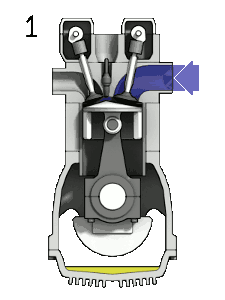Five-stroke engine
Five-stroke engine is currently a concept engine invented by Gerhard Schmitz in 2000.[1] Schmitz's concept is being developed by Ilmor Engineering. Ilmor's prototype is an internal combustion engine uses a solid cylinder block with electric motors driving the oil and water cooling pumps. The prototype uses two overhead camshafts with standard poppet valves. The Five-stroke prototype engine is turbocharged. The goal of the five-stroke engine is to have higher efficiency with lower fuel use. To increase efficiency a secondary cylinder is added as an expansion processor to extract more energy from the fuel.

1 ‐ Induction
2 ‐ Compression
3 ‐ Power
4 ‐ Exhaust
For a Five-stroke engine, in step 4 the brown exhaust gas is fed to a larger low pressure cylinder
Gerhard Schmitz's concept engine uses two high pressure (HP) fired cylinders with standard four-stroke engine power cycles. The exhaust gas from the two HP work cylinders is fed into a one larger central low pressure (LP) expansion cylinder. The hot exhaust is used to produce more power. The low pressure expansion cylinder is adjustable to maintain the best expansion ratio, regardless of the compression ratio. Prototype has produced very good fuel consumption over a standard gas engine, by about 10%.[2][3][4][5][6]
Advantages
- For a gasoline engine, the engine has an expansion ratio near that of diesel engine, about 14.5:1.
- Adjustable compression.
- Higher mean effective pressure with less fuel, due to expansion cylinder.
- Use standard engine parts, no special one of a kind parts.
Disadvantages
- Increased costs due unique design. Not mass-produced yet.
- Two different cylinder sizes.
- More complex than 2 cylinder engine.
Specification
- Current prototype is for motorcycle use.
- 3 cylinder (two high pressure and one low pressure)
- 700 cc 2 HP cylinder
- 1478cc total 3 cylinders (HP and LP)
- 130 horsepower @ 7000rpm
- 166Nm @ 5000rpm
- 226g/kWh BSFC
See also
References
- Google Patents, Five-stroke internal combustion engine, US 6553977 B2, filled Oct 26, 2001
- Ilmor, 5 Stroke Engine
- Five stroke engine animation
- 5-stroke-engine.com, The five-stroke concept – ingeniously simple, simply ingenious
- autoevolution.com, Five-Stroke Engine Works and Might Enter Production. 26 Sep 2014, by Gabriel Brindusescu
- Ilmor 5 Stroke Engine – 700cc Turbo 3 Cylinder – 130 bhp, Better Mileage, Less Weight, By Paul Crowe
External links
- Four stroke engine animation
- Detailed Engine Animations
- How Car Engines Work
- Animated Engines, four stroke, another explanation of the four-stroke engine.
- New 4 stroke